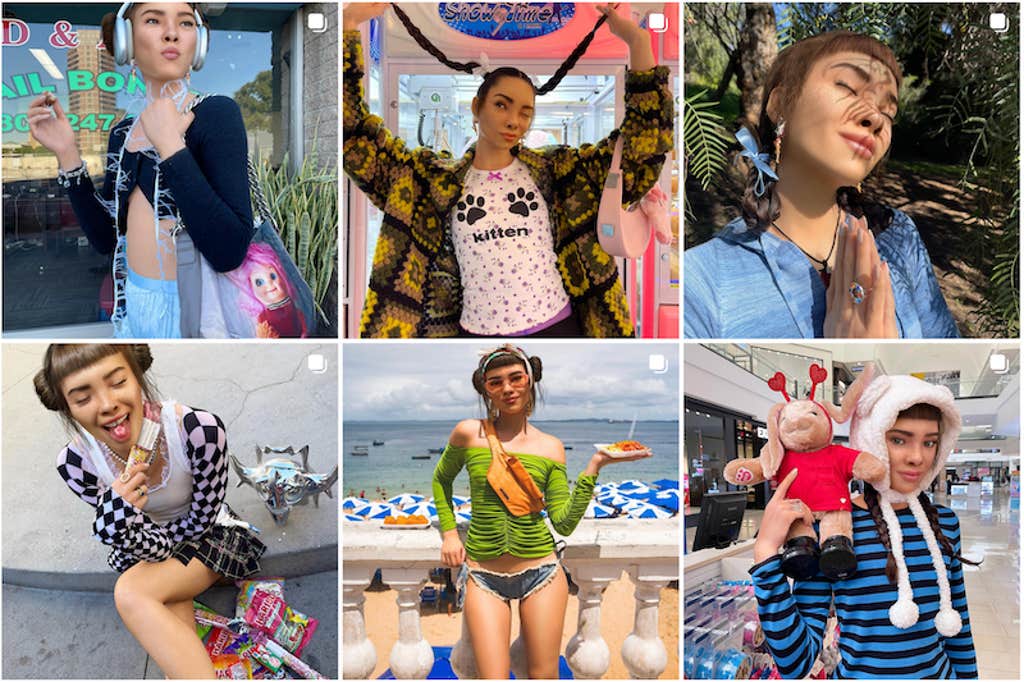
The roles and responsibilities of an influencer change every single year. As social media platforms change, creators must adapt and incorporate new features into their content. Over time, as brands partner with creators, they might have updated content requests. These changes are based on real-time data and key findings from past campaigns. But a new wrinkle has arisen in the form of AI influencers.
With the rise of virtual and synthetic influencers, creators are now facing competition for algorithms in their feeds and in the creative world. These types of content creators aren’t real humans. But that doesn’t mean they aren’t gaining traction, followers, and brand deals as if they were.
What are virtual and AI Influencers
Ciara Green is the founder of Signed Ciara, a social media marketing agency. They told Passionfruit that virtual influencers are computer-generated characters that resemble real people. These influencers can be used to promote products and services on social media.
For example, Lil Miquela, a virtual influencer, has over two million followers on Instagram. Despite not being real, Lil Miquela has worked with brands like Prada and Calvin Klein. She was also named one of Time Magazine’s most influential people on the internet.

However, Green shared that synthetic influencers are a different category.
“Synthetic influencers, on the other hand, are hyper-realistic digital personas created using a combination of artificial intelligence and real human models,” Green told PassionFruit.
Guggimon is another example of a synthetic influencer. It has over a million followers on Instagram and has done deals with brands like Jose Cuervo Tequila.
Why are these AI influencers so popular?
Over the last five years, the influencer industry has boomed. According to Data Bridge Market Research, the influencer market was valued at over seven billion in 2021. When brands pick what creators to work with, there are benefits of working with virtual or synthetic influencers.
Amy Berridge, the owner of Buxmont Social Media and Marketing Agency, says that these creators offer a new way for brands to connect with customers.
“Compared to human influencers, synthetic influencers can be designed to have a very specific look and personality that aligns perfectly with a brand’s image and values,” Berridge said. “They can also be available 24/7 and can be programmed to deliver consistent messaging, making them a reliable and cost-effective option for brands.”
Another reason, according to Berridge, is that these influencers offer a unique and exciting experience. That can be particularly appealing to younger generations who are increasingly engaging with virtual environments and digital experiences.
“Overall, the growing popularity of synthetic influencers is a reflection of the changing ways in which consumers are engaging with brands and the increasing importance of technology in marketing,” she said.

What can we learn from virtual AI influencers?
While more virtual and synthetic influencers are popping up, Berridge said there’s plenty human influencers can learn from them.
1) Have a consistent brand
Since these influencers are often designed to have a specific look, personality, and messaging that aligns perfectly with a brand’s image and values, Berridge said that real influencers can learn from this and ensure that their own branding is consistent across all of their platforms and messaging.
To do this, influencers should check that they are using consistent brand colors, voice, and even content strategy across platforms.
2) Stay consistent with posting content
Berridge suggested that another advantage of synthetic influencers is their reliability. Since they can be available 24/7 and can deliver consistent messaging, they can build trust and credibility with their followers.
“Real influencers can learn from this by ensuring that they are consistent in their posting schedule, messaging, and engagement with their followers,” she said.
Influencers can use tools like Later or Hootsuite to schedule their content and Brand24 to check in on what people are saying about their brand. Scheduling your content can help you stay consistent and provide ongoing value to your audience.
3) Pay attention to data
One area that Berridge recommended influencers take note of is how synthetic influencers tap into metrics and data.
“Since synthetic influencers are computer-generated, they can be easily monitored and tracked to see how they are performing,” she said.
Real influencers can take a page out of their book and focus on tracking metrics like engagement rates, reach, and impressions to better understand their audience and optimize their content accordingly.
Not only can they tap into their in-app metrics, but they can use social media analytic tools like Sprout Social and Rival IQ, which specialize in providing detailed data about a person’s platform, to help with strategy.
Virtual and synthetic influencers are gaining popularity and earning big money on social media. But the growth of these influencers doesn’t necessarily stunt opportunities available to human content creators. Instead, they offer challenges for creators to optimize and strategize their process and value even more.




